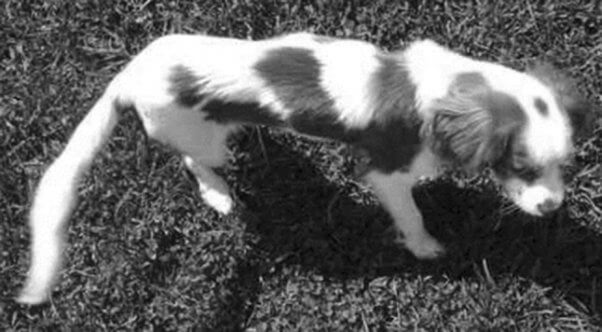PETA Sued Texas A&M to Get Records on Buckley’s Sad, Short Life
Update (November 4, 2022): VICTORY! Texas A&M University has confirmed that it will release the nine healthy golden retrievers it had transferred from its failed canine muscular dystrophy laboratory to the veterinary school!
This momentous news comes after PETA’s hard-fought campaign that began with our shocking exposé of the school’s deplorable laboratory. Our relentless pressure ended its cruel breeding of dogs to develop this crippling disease and led to the release of more than 50 dogs.
But we never gave up on these nine betrayed golden retrievers. We campaigned hard—and now the dogs will be in homes before the end of the year.
You can read more about our win for the nine dogs here.
Update (March 11, 2019): New records obtained by PETA—which we had to sue to get—shed more light on Buckley’s story. You’ll see why Texas A&M wanted to keep it secret.
Born with canine muscular dystrophy (MD), Buckley was a small, vulnerable cavalier King Charles spaniel puppy who needed a family to provide him with a loving home and treatment for his debilitating disease. Instead, experimenters shuttled him from facility to facility over nearly five years. His life was characterized by confinement to a cage, loneliness, chronic pain, and frightening tests.
He was born on August 13, 2008, at a Tennessee dog breeder to be sold as a companion animal. His father was named Marlon Brando and his mother Olivia de Havilland, but these names suggesting a lineage of Hollywood royalty didn’t protect Buckley from being treated like a worthless, disposable object. In December of that year, he was sold to a family in Snellville, Georgia. They noticed that he was underweight and had trouble eating—he ate very slowly and sometimes extended his neck when swallowing food and water. He also salivated excessively, suffered from a cough, had nasal congestion, and tired quickly. The family took him to the University of Georgia (UGA) for treatment, but on March 30, 2009, they signed him over to Peter Nghiem, a UGA veterinarian.
On April 4, 2009, after a series of tests suggested that Buckley had canine MD, Nghiem transferred ownership to Joe Kornegay—a mere five days after obtaining custody of the dog. Buckley was shipped to a laboratory at the University of North Carolina at Chapel Hill, where Kornegay was breeding dogs to have canine MD. A record documenting the transfer describes Buckley as having a “red and white hair coat with [a] thumbprint on top of [his] head.” The puppy was only 7 months old at the time and weighed less than 10 pounds. Four days later, he contracted tapeworms. And two months after that, a chunk of muscle was cut out of his right side. Records say that he was “[s]low to recover.”
Three years later, Buckley was shipped to yet another laboratory—this time Texas A&M University, where he continued to be used in experiments until the day he died.
Originally posted on July 24, 2017:
Little Buckley was a chestnut-and-white Cavalier King Charles spaniel who was born in October 2008. His breeder described him as smaller and less boisterous than his littermates. As he grew older, he suffered from frequent coughing and lethargy, and he had difficulty chewing and swallowing. He tired easily and collapsed after even short periods of trotting around.
When he was about 6 months old, he was diagnosed with canine muscular dystrophy (MD), a progressive and painful disease that causes muscles to deteriorate. It was time to dote over him and make him as comfortable as possible in the time that he had left, right? Wrong. Instead, his owner “donated” him to experimenters at the University of Georgia’s Small Animal Veterinary Teaching Hospital. This marked the beginning of nearly five years of a life characterized by cage confinement, loneliness, chronic pain, and frightening tests.
Shortly after arriving at the University of Georgia, Buckley was handed off to experimenters at the University of North Carolina at Chapel Hill, where it was noted that he was very thin and suffering from a heart murmur. He was plagued by thick nasal discharge and congestion in his lungs.
Despite his deteriorating condition—he weighed less than 11 pounds—Buckley was transferred in June 2012 to Texas A&M University (TAMU), where he endured painful experimental procedures at the hands of Joe Kornegay and Peter Nghiem. Many dogs in the university’s laboratory are confined to barren cages without even the comfort of a blanket and are often covered with their own saliva and the slop that they’re fed because they’re too weak to eat or swallow properly.

Life for Buckley didn’t get any better at TAMU. His records from that time show that he suffered from upper respiratory infections and nasal discharge. He also experienced ulcerations that caused corneal scarring in both eyes.
As he was about to be used in yet another experiment, his short, miserable life came to an abrupt end. He died as a result of complications from anesthesia. After his death, his body was dissected, and his tissues were harvested for examination.
Buckley was born with a serious illness, but his suffering was greatly exacerbated by years of exploitation. Throughout his life and even after his death, Buckley was treated like a piece of property, an object to tinker with, rather than a desperately ill being. The experimenters weren’t concerned about his well-being or about curing his disease. He was forced to undergo painful procedures and was deprived of anything resembling a normal family life, the very least that we owe unlucky individuals like him.
In a recent paper, Kornegay writes that the results of canine MD experiments “cannot accurately predict the potential human immune responses to [Duchenne muscular dystrophy] gene therapies.” In other words, these horrors won’t help human patients suffering from this disease. Despite this admission, he and fellow experimenters at TAMU are considering breeding more dogs like Buckley to have this disease. They write that they are “evaluating options to perpetuate [the Cavalier King Charles spaniel] model.”
This is more proof that these experimenters place greater value on staying on the grant gravy train than on mitigating suffering.
We need to shut down these experiments so that no more dogs are intentionally bred to have this debilitating disease and condemned to a life of misery like the ones that Jelly, Peony, and Buckley endured.
What You Can Do
Please urge TAMU to close its dog laboratories, to stop breeding animals afflicted with muscular dystrophy, to release all dogs for adoption into good homes, and to redirect resources toward humane and effective research methods.



